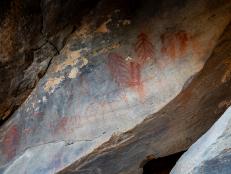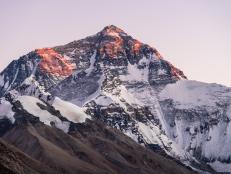Articles
Showing 1,681 - 1695 of 2,628 results
Why Pluto Isn’t a Planet, but (Maybe) Should Be
What, exactly, is a “planet”? For ancient astronomers it was pretty easy. When they stared up at the night sky, they saw a) the sun, b) the moon, c) a lot of fixed stars, d) a few wandering points of light. Those vagabonds were the planets. Indeed, our word planet comes from the Greek word for “wanderer”.
The Space Titans Are Here
Space travel isn’t just for NASA astronauts now. How did we get here, and what is next in the incredible race to space? SPACE TITANS: MUSK, BEZOS, BRANSON, an all-new special streaming Thursday, November 4 on discovery+, will follow the world’s most successful entrepreneurs who are putting billions of dollars on the line to launch a revolution in space.
Ancient Rock Art of the Mojave National Preserve
My first expedition to Mojave National Preserve, California, was an epic adventure that felt ripped right off the pages of an Indiana Jones movie. An ancient cave in an unassuming desert landscape that at high noon, reveals shafts of light into a soft, sandy cave, like an underground sundial.
What is “Dark Flow”?
It sounds super-scary: something from outside the universe, a force so unimaginable, is pulling every single galaxy towards it. What monstrosity of cosmic physics could it be?
The Milky Way Broke its Arm (But is Totally Okay)
The Milky Way is a giant, magnificent, truly transcendently beautiful spiral arm galaxy. It’s too bad we can’t get a decent picture of it. The problem is that we live inside it, and so astronomers have to work extra-hard to construct an accurate map.
The First All-Black Team Will Climb Mount Everest Next Year
By scaling the 29,032-foot-peak, Full Circle Everest hopes to empower people of color to explore the outdoors.
William Shatner Becomes Oldest Man to Travel to Space After Successful Blue Origin Space Flight
On the morning of October 13, William Shatner joined the crew of New Shepard for its second crewed flight, NS-18. Due to a few holds, the scheduled 10A liftoff was delayed by about 50 minutes from Blue Origin's Launch Site One in Texas. Despite the delays, liftoff and touchdown went off without a hitch, making Star Trek star William Shatner the oldest man to go to space.
William Shatner is going where no 90-year-old has gone before
The Star Trek star will become the oldest person to go to space when he launches aboard a Blue Origin rocket on Wednesday, October 13. Watch live coverage on Space Launch LIVE: Shatner in Space on Discovery and Science Channel starting at 8:30A ET with liftoff scheduled for 10A ET.
Do Octopuses Dream?
New footage shows a sleeping octopus changing colors, indicating the creature may be dreaming.
Hydrogen Ready to Ignite as Transport Network and Technology Takes Off
Transport is undergoing a massive transformation so it can meet society’s demands for a low-carbon economy. Introducing electric vehicles (EVs) and declining gasoline and diesel use are helping, but zero-carbon hydrogen can speed up both the transition and long-term decarbonization of transport.
The King of Chunks Has Been Crowned
A four-time champion, 480 Otis proved that age is just a number and appetite is the real judge of awesomeness.
Jimiyu the Chimp Just Got Vaccinated
On the last day of September, an unlikely patient received a COVID-19 vaccination. Jimiyu, a 29-year-old male chimpanzee living at Saint Louis Zoo in Missouri, became the first animal at the zoo to receive a dose of Zoetis.
When Did the First Stars Shine?
Our universe is home to up to two trillion galaxies, with each galaxy hosting hundreds of billions of stars. That’s…a lot of stars. Each one a ball of fearsome energies, powered by the nuclear fusion of fundamental elements in their hearts. Each one pouring out light into the empty cosmos, illuminating our universe for our wonder and delight.
Global Meltdown: Scientists Race to Gather Crucial Climate Data from Glaciers
Glaciers store a vast amount of important climate data within their frozen rivers of snow and ice. But many of the world’’s 220,000 glaciers are under threat from global warming and are melting at an accelerating rate. Now scientists are in a race to gather long-frozen records of Earth’s past climate from the ice.
Get ready for Wednesdays packed with Moonshiners, Master Distiller and Smoke Ring
It’s boom time for moonshine! New seasons of Moonshiners and Master Distiller, plus Moonshiners: Smoke Ring, are all coming October 27 on Discovery.






















